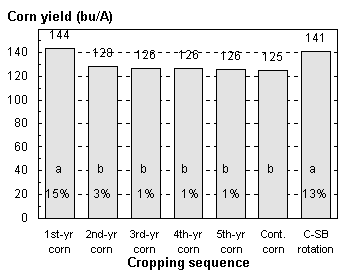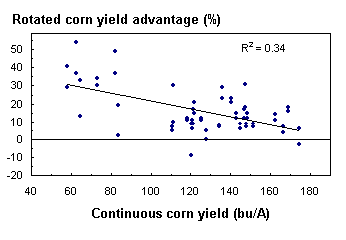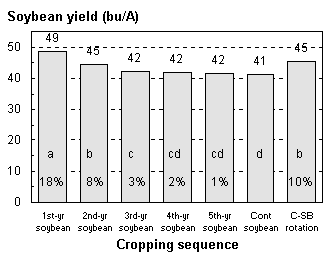April, 1997
<\br>
Field Crops 27.426; 28.426-14
The Corn and Soybean Rotation Effect
Joe Lauer, Paul Porter, and Ed Oplinger
Summary
Corn-soybean rotation resulted in higher corn and soybean yields than the respective
monocultures. For both corn and soybean, the rotation effect - or perhaps more accurately,
the continuous cropping yield decline - was observed to be greater in low-yielding
environments than in high-yielding environments. Yields of corn in an annual soybean/corn
rotation or first-yr after 5 yr of consecutive soybean were not different from each
other. First-yr soybean after 5 yr of consecutive corn, yielded more than soybean
in the corn/soybean rotation, and both of these sequences yielded more than the
continuous soybeans. These results show that the commonly practiced corn-soybean
rotation optimizes corn yields, but not soybean yields.
A first-century B.C. text states "some crops are to be planted not so much
for the immediate yield as with a view to the following year." During the early
1980s it was documented that corn grown on land planted to corn the previous year
yielded 10 to 15% less grain than corn rotated with certain other crops. Also, soybeans
yielded 10 to 15% better when rotated with corn rather than grown continuously.
Yield increases associated with crop rotation have been referred to as the "rotation
effect."
Three of the longest on-going studies designed to evaluate corn-soybean cropping
sequences in the northern Corn Belt were initiated in the early 1980s at two locations
in Minnesota and one location in Wisconsin. The studies were established near Lamberton,
MN in 1981 on a Webster clay loam soil, Waseca, MN in 1982 on a Nicollet clay loam
soil, and near Arlington, WI in 1983 on a Plano silt loam soil. Recommended practices
for optimum production were followed each year.
Results - Corn
Combining the data from all three locations for all years (29 environments), first-yr
corn and corn in the corn-soybean rotation yielded significantly more than the other
cropping sequences (Fig. 1). There was a 15% increase in first-yr corn yield compared
to continuous corn. Corn yield from the soybean-corn rotation was 13% greater than
from continuous corn. Second-, third-, fourth-, and fifth-yr corn yields were no
different from continuous corn.
Figure 1.

In 15 of 29 environments there was a positive yield effect observed for both first-yr
and annually rotated corn compared to continuous corn. In no environment was there
a significant negative effect of rotations compared to continuous corn. There was
a linear relationship between the corn yield advantage in the annual rotation and
first-yr corn versus the yield of continuous corn (Fig. 2). As the yield of continuous
corn increased (better environments), the yield advantage of rotation declined.
In low-yielding environments, first-yr corn and corn grown in annual rotation often
yielded greater than 25% over continuous corn. Whereas in high-yielding environments,
the yield advantages for first-yr corn and corn grown in annual rotation were generally
less than 15%.
Figure 2.

High-yielding corn environments were characterized by high, but not excessive rainfall,
temperatures, and solar radiation during the growing season. Lowest-yielding environments
occurred in the hottest, driest, and sunniest growing season (in 1988 at all three
locations) and the coolest, wettest, and cloudiest growing season (in 1993 at all
three locations).
Results - Soybean
When averaged across all years, first-yr soybean yields were the highest of any
soybean cropping sequence at all three locations (Fig. 3). Combining the data from
all three locations for all years (28 environments) resulted in an 18, 8, and 3%
increase in first-, second-, third-yr soybean yields compared to continuous soybeans.
Yields from the fourth- and fifth-yr soybeans were not different from continuous
soybeans. Soybean yield in the corn-soybean rotation was 10% greater than in continuous
soybeans.
Figure 3.

In 20 of 28 environments there was a positive yield effect for first-yr soybean
compared to continuous soybeans, whereas in only nine of 28 environments there was
a positive yield effect for annual rotation compared to continuous soybeans. In
no environment was there a significant negative yield effect of rotation compared
to continuous soybeans. With higher continuous soybean yields (better environments)
the advantage of rotation declined (Fig. 4). In low-yielding environments, the yield
advantages of first-yr soybean and soybean grown in annual rotation varied greatly
and often exceeded 25%. Whereas in high-yielding environments, the yield advantages
for first-yr and annually rotated soybean were generally less than 15%.
Figure 4.

Moderate rainfall, temperatures and solar radiation characterized high-yielding
soybean environments. Low-yielding soybean environments included below normal early-season
rainfall (1988 at Lamberton and Waseca, 1989 at Lamberton) or low early-season temperatures
(1992 at Lamberton and Waseca, 1993 at Lamberton). Seasons when there was a large
rotation effect included those when growing degree units from planting through July
were low (1992 and 1993 at Lamberton and Arlington, and 1992 at Waseca).
Conclusions
First year and annual rotation corn yields increased by 15 and 13%, compared to
continuous corn. Yield from second-, third-, fourth-, and fifth-yr corn was equivalent
to yield of continuous corn. Following 5 yr of consecutive soybean, first-yr corn
yield was greater than second-yr corn yield, but no further yield loss would occur
if corn were grown on the same land for additional years. This statement could not
be made for soybean. Soybean yields in the annual rotation and first-yr soybean
increased by 10 and 18%, respectively, compared to continuous soybean yields. An
increase of 8% in second-yr soybean compared to continuous soybean was observed.
Third-yr soybean had a 3% yield increase over continuous soybean while the fourth-
and fifth-yr soybean were equivalent in yield to continuous soybean. A 6% decrease
in soybean yield was observed when soybean was grown in an annual corn-soybean rotation
compared to first-yr soybean after multiple years of corn. These results show the
prevailing practice of annually rotating corn and soybean does not give maximum
soybean yields.